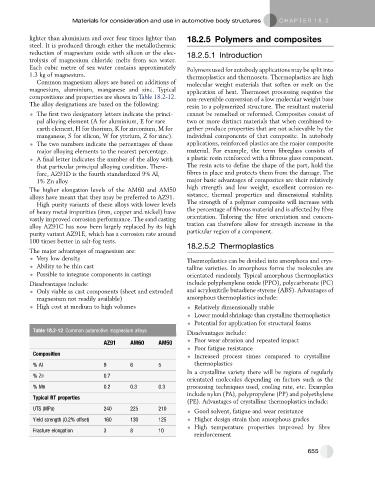Page 647 - Automotive Engineering Powertrain Chassis System and Vehicle Body
P. 647
Materials for consideration and use in automotive body structures C HAPTER 18.2
lighter than aluminium and over four times lighter than 18.2.5 Polymers and composites
steel. It is produced through either the metallothermic
reduction of magnesium oxide with silicon or the elec- 18.2.5.1 Introduction
trolysis of magnesium chloride melts from sea water.
Each cubic metre of sea water contains approximately Polymers used for autobody applications may be split into
1.3 kg of magnesium. thermoplastics and thermosets. Thermoplastics are high
Common magnesium alloys are based on additions of molecular weight materials that soften or melt on the
magnesium, aluminium, manganese and zinc. Typical application of heat. Thermoset processing requires the
compositions and properties are shown in Table 18.2-12. non-reversible conversion of a low molecular weight base
The alloy designations are based on the following: resin to a polymerized structure. The resultant material
The first two designatory letters indicate the princi- cannot be remelted or reformed. Composites consist of
pal alloying element (A for aluminium, E for rare two or more distinct materials that when combined to-
earth element, H for thorium, K for zirconium, M for gether produce properties that are not achievable by the
manganese, S for silicon, W for yttrium, Z for zinc). individual components of that composite. In autobody
The two numbers indicate the percentages of these applications, reinforced plastics are the major composite
major alloying elements to the nearest percentage. material. For example, the term fibreglass consists of
A final letter indicates the number of the alloy with a plastic resin reinforced with a fibrous glass component.
that particular principal alloying condition. There- The resin acts to define the shape of the part, hold the
fore, AZ91D is the fourth standardized 9% Al, fibres in place and protects them from the damage. The
1% Zn alloy. major basic advantages of composites are their relatively
high strength and low weight, excellent corrosion re-
The higher elongation levels of the AM60 and AM50
alloys have meant that they may be preferred to AZ91. sistance, thermal properties and dimensional stability.
High purity variants of these alloys with lower levels The strength of a polymer composite will increase with
the percentage of fibrous material and is affected by fibre
of heavy metal impurities (iron, copper and nickel) have
vastly improved corrosion performance. The sand casting orientation. Tailoring the fibre orientation and concen-
alloy AZ91C has now been largely replaced by its high tration can therefore allow for strength increase in the
purity variant AZ91E, which has a corrosion rate around particular region of a component.
100 times better in salt-fog tests.
18.2.5.2 Thermoplastics
The major advantages of magnesium are:
Very low density Thermoplastics can be divided into amorphous and crys-
Ability to be thin cast talline varieties. In amorphous forms the molecules are
Possible to integrate components in castings orientated randomly. Typical amorphous thermoplastics
Disadvantages include: include polyphenylene oxide (PPO), polycarbonate (PC)
Only viable as cast components (sheet and extruded and acrylonitrile butadiene styrene (ABS). Advantages of
magnesium not readily available) amorphous thermoplastics include:
High cost at medium to high volumes Relatively dimensionally stable
Lower mould shrinkage than crystalline thermoplastics
Potential for application for structural foams
Table 18.2-12 Common automotive magnesium alloys
Disadvantages include:
Poor wear abrasion and repeated impact
AZ91 AM60 AM50
Poor fatigue resistance
Composition
Increased process times compared to crystalline
%Al 9 6 5 thermoplastics
In a crystalline variety there will be regions of regularly
% Zn 0.7
orientated molecules depending on factors such as the
% Mn 0.2 0.3 0.3 processing techniques used, cooling rate, etc. Examples
include nylon (PA), polypropylene (PP) and polyethylene
Typical RT properties
(PE). Advantages of crystalline thermoplastics include:
UTS (MPa) 240 225 210 Good solvent, fatigue and wear resistance
Yield strength (0.2% offset) 160 130 125 Higher design strain than amorphous grades
High temperature properties improved by fibre
Fracture elongation 3 8 10
reinforcement
655

